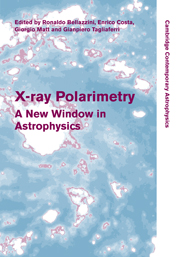Book contents
- Frontmatter
- Contents
- List of contributors
- Preface
- 1 X-ray polarimetry: historical remarks and other considerations
- Part I Polarimetry techniques
- Part II Polarized emission in X-ray sources
- 14 Probing strong gravity effects with X-ray polarimetry
- 15 X-ray polarization from black holes in the thermal state
- 16 Strong-gravity effects acting on polarization from orbiting spots
- 17 Polarization of thermal emission from accreting black holes
- 18 X-ray polarimetry and radio-quiet AGN
- 19 The soft X-ray polarization in obscured AGN
- 20 The polarization of complex X-ray sources
- 21 Polarization of Compton X-rays from jets in AGN
- 22 Polarization of X-ray lines from galaxy clusters and elliptical galaxies
- 23 Polarization characteristics of rotation-powered pulsars
- 24 Polarized X-rays from magnetized neutron stars
- 25 Polarization properties of X-ray millisecond pulsars
- 26 X-ray polarization signatures of neutron stars
- 27 Polarization from the oscillating magnetized accretion torus
- 28 X-ray polarization from accreting white dwarfs and associated systems
- 29 Polarization of pulsar wind nebulae
- 30 X-ray polarization of gamma-ray bursts
- 31 Central engine afterglow from GRBs and the polarization signature
- 32 GRB afterglow polarimetry past, present and future
- 33 Gamma-ray polarimetry with SPI
- 34 INTEGRAL/IBIS observations of the Crab nebula and GRB 041219A polarization
- 35 Fermi results on the origin of high-energy emission in pulsars
- 36 Diagnostics of the evolution of spiral galaxies in a cluster environment
- Part III Future missions
- Author index
- Subject index
19 - The soft X-ray polarization in obscured AGN
from Part II - Polarized emission in X-ray sources
Published online by Cambridge University Press: 06 July 2010
- Frontmatter
- Contents
- List of contributors
- Preface
- 1 X-ray polarimetry: historical remarks and other considerations
- Part I Polarimetry techniques
- Part II Polarized emission in X-ray sources
- 14 Probing strong gravity effects with X-ray polarimetry
- 15 X-ray polarization from black holes in the thermal state
- 16 Strong-gravity effects acting on polarization from orbiting spots
- 17 Polarization of thermal emission from accreting black holes
- 18 X-ray polarimetry and radio-quiet AGN
- 19 The soft X-ray polarization in obscured AGN
- 20 The polarization of complex X-ray sources
- 21 Polarization of Compton X-rays from jets in AGN
- 22 Polarization of X-ray lines from galaxy clusters and elliptical galaxies
- 23 Polarization characteristics of rotation-powered pulsars
- 24 Polarized X-rays from magnetized neutron stars
- 25 Polarization properties of X-ray millisecond pulsars
- 26 X-ray polarization signatures of neutron stars
- 27 Polarization from the oscillating magnetized accretion torus
- 28 X-ray polarization from accreting white dwarfs and associated systems
- 29 Polarization of pulsar wind nebulae
- 30 X-ray polarization of gamma-ray bursts
- 31 Central engine afterglow from GRBs and the polarization signature
- 32 GRB afterglow polarimetry past, present and future
- 33 Gamma-ray polarimetry with SPI
- 34 INTEGRAL/IBIS observations of the Crab nebula and GRB 041219A polarization
- 35 Fermi results on the origin of high-energy emission in pulsars
- 36 Diagnostics of the evolution of spiral galaxies in a cluster environment
- Part III Future missions
- Author index
- Subject index
Summary
The soft X-ray emission in obscured active galactic nuclei (AGN) is dominated by emission lines, produced in a gas photoionized by the nuclear continuum and probably spatially coincident with the optical narrow-line region (NLR). However, a fraction of the observed soft X-ray flux appears like a featureless power law continuum. If the continuum underlying the soft X-ray emission lines is due to Thomson scattering of the nuclear radiation, it should be very highly polarized. We calculated the expected amount of polarization assuming a simple conical geometry for the NLR, combining these results with the observed fraction of the reflected continuum in bright obscured AGN.
Introduction
The presence of a ‘soft excess’, i.e. soft X-ray emission above the extrapolation of the absorbed nuclear emission, is very common in low-resolution spectra of nearby X-ray obscured active galactic nuclei (AGN). It is generally very difficult to discriminate between thermal emission, as expected by gas heated by shocks induced by AGN outflows or episodes of intense star formation, and emission from a gas photoionized by the AGN primary emission. However, the high energy and spatial resolution of XMM-Newton and Chandra have allowed us to make important progress in the last few years.
The photoionization signatures
The high-resolution spectra of the brightest obscured AGN, made available by the gratings aboard Chandra and XMM-Newton, revealed that the ‘soft excess’ observed in CCD spectra was due to the blending of strong emission lines, mainly from He- and H-like transitions of light metals and L transitions of Fe (see Figure 19.1, e.g).
- Type
- Chapter
- Information
- X-ray PolarimetryA New Window in Astrophysics, pp. 130 - 135Publisher: Cambridge University PressPrint publication year: 2010
- 1
- Cited by

